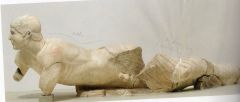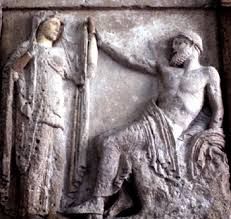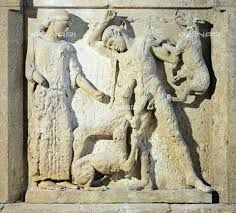![]()
![]()
![]()
Use LEFT and RIGHT arrow keys to navigate between flashcards;
Use UP and DOWN arrow keys to flip the card;
H to show hint;
A reads text to speech;
51 Cards in this Set
- Front
- Back

|
6.88 Attic bilingual (black figure and red-figure) amphora from Andokides' workshop: Herakles driving a bull. c. 520 BC. Potted by Andokides, painted by the Andokides Painter, although there is debate over whether the two sides were painted by the same person or two different people. |
|

|
6.89 Attic red-figure calyx krater by Euphronios: Herakles strugglign with Antaios. c. 510-500 BC. Euphronios is a member of the highly competitive red-figure pioneer group. The lines are done with care; profiles have thicker lines, while lesser details have thinner lines. |
|

|
6.90 Attic red-figure [belly] amphora by Euthymides: revelers. c. 510-500 BC. Revelers are an appropriate subject matter for a vase made to hold wine. The inscription on the amphora reads: "Euphronios never did anything like this." |
|

|
6.92 Attic red-figure [neck] amphora attributed to the Berlin Painter: a reveler. c. 490-480 BC. The Berlin Painter seemed to be pulling back from the gaudiness of other painters; he seems to prefer elegance of one figure or a close group over an elaborate narrative. |
|

|
7.12 Plan of the Temple of Zeus, Olympia, c. 460 BC. Largest temple on the Greek mainland of this period. Doric. |
|

|
7.13 Temple of Zeus, Olympia, east pediment. c. 460 BC. Depicts a chariot race between Pelops and Oinomaos, but the version of the myth depicted is unclear. |
|

|
7.14 Temple of Zeus, Olympia, east pediment: central figures. c. 460 BC. Marble. Zeus is present as a mediator, overseer, or witness to the oaths of honor. The figures present a good example of the severe style (heavy jaw, pouting lips, thick eyelids) and also the contrapposto style: balanced standing pose with weight unequally distributed on the legs; tilted hips; dynamic but at rest. |
|

|
7.15 Temple of Zeus, Olympia, east pediment: the seer Iamos. c. 460 BC. Marble. Figure shows an interest of the sculptor in representing age and psychological states. |
|

|
7.16 Temple of Zeus, Olympia, east pediment: reclining corner figure (personification of the river Kladeos). c. 460 BC. Marble. |
|

|
7.17 Temple of Zeus, Olympia, west pediment. c. 460 BC. Depicts the Battle of the Lapiths and the Centaurs at the wedding of Peirithous and Hippodameia. |
|

|
7.18 Temple of Zeus, Olympia, west pediment: Apollo c. 460 BC. Marble. Good example of the severe style. |
|

|
7.19 Temple of Zeus, Olympia, west pediment: centaur grappling with Lapith woman. c. 460 BC. Marble. The blank expression of the Lapith woman is juxtaposed with the fierce, passionate expression of the centaur. This is perhaps demonstrating a contrast between humanity and beastiality. |
|

|
7.20 Temple of Zeus at Olympia. Reconstruction drawing of a metope and adjacent triglyphs: Athena, Herakles (supporting the heavens), and Atlas (bringing the apples of the Hesperides). c. 460 BC. One of the Twelve Labors of Herakles. |
|

|
7.21 Temple of Zeus, Olympia, metope: Herakles, Athena, and the Stymphalian Birds. c. 460 BC. Marble. One of the Twelve Labors of Herakles. |
|

|
7.22 Temple of Zeus, Olympia, metope: Herakles and the Cretan Bull. c. 460 BC. Marble. The fact that there are perfectly twelve metopes on the temple, and that they all depict what are now known as the Twelve Labors of Herakles, it is speculated that these twelve metopes are the inspiration for the standardization. |
|

|
7.23 Temple of Zeus, Olympia. Section showing the cult statue. Later 5th century BC. Phidias, 430 BC. The style was chryselephantine, meaning that it was a hollow wooden statue coated by gold and ivory. Wooden nature means that it is now lost, but depictions are found on Roman coins, and a written description by Pausinias survives. |
|

|
7.27 Temple E, Selinus, metope: Zeus and Hera. c. 460-450 BC. Limestone, with marble for Hera's head, feat, and arms. Metopes are the only sculptures on the temple. Each features one man and one woman. This is a depiction of a loving scene between the husband and wife pair of Zeus and Hera.
|
|

|
7.28 Temple E, Selinus, metope: death of Aktaion. c. 460-450 BC. Limestone, with marble exposed for female flesh. Artemis sets Aktaion's dogs on him when he offends her; a very different scene from the one between Zeus and Hera. |
|

|
7.35 The Kritios Boy, kouros attributed to the sculptor Kritios. c. 475 BC. Marble. Among the last of the Archaic kouroi and among the first of the new figures in which the movement of the body is organically explored (controposto). May be Theseus. |
|

|
7.36 The Tyrannicides. Roman copies of c. 477 BC Greek bronzes by Kritios and Nesiotes. Marble. Depicts Harmodius and Aristogeition, real people; such a depiction is somewhat rare and unusual, especially since it was displayed in such a prominent way, in the agora for all to see. |
|

|
7.39 Diskobolos by Myron. Roman copy of a c. 450 BC bronze Greek original. Marble. Anatomy and movement seem to be accurate and convincing. The face is placid and detached; is this the ideal face? This sculptor was more famous in antiquity for a statue of a realistic cow. |
|

|
7.40 Angelitos' Athena. c. 470. Marble. Was constructed soon after the Persian destruction; it may have been an offering towards recovery. It was probably originally on a column. Aegis identifies her. Contrapposto style. |
|

|
7.42 Artemision Zeus, or Poseidon, from the sea near Cape Artemision. c. 460-450 BC. Bronze. Once held something that he is in the process of throwing (lightning bolt? trident?). The bronze only survived (being melted down for weapons) because it went down with a ship. Relatively accurate depiction of the anatomy, although he seems more relaxed than he should be for his action. |
|

|
7.46 Mourning Athena relief, from Athens. c. 470 BC. Marble. Crafted soon after Persian destruction; the city was likely in ruins. Perhaps she is mourning those who lost their lives in front of a grave stele featuring the names of the dead. |
|

|
8.3 Parthenon, Athens, view from the northwest. 447-432 BC. Pentelic marble. |
|

|
8.4 Plan of the Parthenon, Athens. c. 447-432 BC. |
|

|
8.5 Parthenon, northeast corner detail, showing Doric column and capital, architrave and frieze course (triglyph and metope), and cornices. 447-438 BC. Marble. |
|

|
8.6 Platform of the Parthenon, showing curvature on facades and flanks. |
|

|
8.7 Parthenon, Athens, south metope 27: struggle between Lapith and centuar. 447-438 BC. Marble. |
|

|
8.8 Parthenon, Athens. Drawing of a reconstruction of the west pediment. Depicts the contest between Athena and Poseidon for patronship of the city. |
|

|
8.9 Parthenon, Athens, west pediment: Kekrops and daughter in situ. 437-432 BC. Marble. |
|

|
8.10 Parthenon, Athens, west pediment: reclining male corner figure (personification of the river Ilissos). 437-432 BC. Marble. |
|

|
8.12 Parthenon, Athens. Drawing of a reconstruction of the east pediment. Depicts the birth of Athena. Helios drives his chariot up as Selene drives hers down. |
|

|
8.13 Parthenon, Athens, east pediment: reclining male figure (Ares? Dionysus? Herakles? Mount Olympus?). 437-432 BC. Marble. |
|

|
8.14 Parthenon, Athens, east pediment: two seated female figures (Demeter and Kore) and a messenger (Iris? Artemis?). 437-432 BC. Marble. |
|

|
8.15 Parthenon, Athens, east pediment: three female figures (Hestia? Dione? and Aphrodite). |
|

|
8.16 Parthenon, Athens, west frieze in situ, from below: cavalcade in preparation. 447-438 BC. Marble. |
|

|
8.17 Diagram of the Parthenon frieze. |
|

|
8.18 Parthenon, Athens, east frieze: peplos incident. 447-438 BC. Marble. |
|

|
8.19 Parthenon, Athens, west frieze: riders. 447-438 BC. Marble |
|

|
8.20 Parthenon, Athens, north frieze: cavalcade. 447-438 BC. Marble. |
|

|
8.21 Parthenon, Athens, south frieze: chariot and four horses. 447-438 BC. Marble. |
|

|
8.22 Parthenon, Athens, north frieze: water carriers. 447-438 BC. Marble. |
|

|
8.23 Parthenon, Athens, east frieze: women and marshals. 447-438 BC. Marble. |
|

|
8.26 Varvakeion statuette, a Roman version of the statue of Athena Parthenos. 2nd-century AD copy of the gold and ivory statue by Phidias of 438 BC. Marble. |
|

|
8.29 Temple of Athena Nike, Athens, view from the east showing tetrastyle columns of the facade and monolithic columns. 420s BC. Marble. |
|

|
8.30 Nike (Victory) adjusting her sandal, from the balustrade around the precinct of Athena Nike. c. 410-405 BC. Marble. |
|

|
8.31 Plan of the Erechtheion, Athens. c. 430s-406 BC. |
|

|
8.32 Erechtheion, Athens, north porch from the east. c. 430s-406 BC. Marble with black Eleusinian limestone for frieze blocks to which marble figures were attached. |
|

|
8.33 Caryatid from the south porch of the Erechtheion, Acropolis of Athens. c. 420-410 BC. Marble. |
|

|
8.43 Doryphoros by Polykleitos, from Pompeii. Roman copy of a bronze Greek original of c. 440 BC. Marble. Doryphoros means "spear-bearer": he originally held a spear. The statue represents Polykleitos' idea about the symmetric commesurability of parts (all parts relate to one another and to the whole) as espoused in his Kanon. Evolution of contrapposto signifies change from Early to High Classical. |

